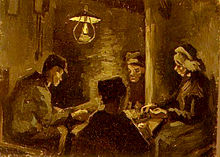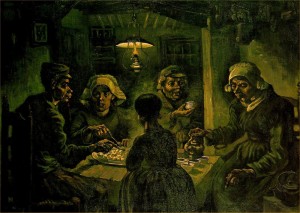
“What I want and aim at is to confoundedly difficult, and yet I do not think I aim too high. I want to do drawings which touch some people…” Vincent Van Gogh in a letter to his brother, Theo, 1882.
Vincent Van Gogh painted with great passion. Any person can see this when studying the thick impasto brush strokes he used in his paintings. But I have no feelings of uncertainty that with every stroke he made, it was an effort to passionately communicate with people–to touch them. The letter he wrote to his brother only confirms my suspicion. Later, he used words like “express,” “teach,” and “feel,” when talking about what he wanted to accomplish with his art and how it should be understood. Yet, when you think about it, he is still talking about touching people.
In the same letter, he wrote: “…what I want to express, in both figure and landscape, isn’t anything sentimental or melancholy, but deep anguish. In short, I want to get to the point where people say of my work–‘that man feels deeply, that man feels keenly.’”
For years I heard and imagined Van Gogh to be mentally deranged, impetuous and unstable, and I assumed that he had to go to some dark place to imagine the world in the colors and wild passionate strokes of the brush that he used in his art. It turns out that except for a small portion of his working life, he was one of the most prodigious and industrious artists of his generation.
In more than 750 surviving letters (mostly to his brother) we have a clear understanding of the artist. In considerable length and complexity, Van Gogh gives us a moving testimony of self-examination as both artist and human being. His knowledge of art ranged from the masters to the obscure. He was a Dutchman that spoke fluent English as well as French. He was well read, totally at home with Shakespeare, Dickens, Flaubert, and Emile Zola. Some of his paintings were done from vicarious imaging of scenes from some of the books he read.
In 1884, Van Gogh and his brother, Theo, discussed their interest about a novel they both were reading, Emile Zola’s. Au Bonbeur des Dames. Van Gogh wrote: “Zola’s description of a room with women in the twilight, women often already over thirty, up to fifty, such a dim mysterious corner. I think it splendid, yes, sublime.” Shortly after writing this, the artist began his group of twilight portrait studies that contributed to preparations for his painting, The Potato Eaters.

Early in the progress of The Potato Eaters, Van Gogh departed from the diffuse effects of daylight opting out for a suspended oil lamp in a darkened room, and with the near-symmetry of the composition it tended to echo such biblical subjects of the Last Supper.
He also seemed to be paying homage to the art of the artist whose work meant so much to him, Jean-Francois Millet.

In his preparations for The Potato Eaters, Van Gogh  announced to his brother that he was going to “paint fifty heads just for the experience.” He convinced several men, women, and children to sit for him. Most of these sat for him in a dark room lit with an oil lamp. The two portraits shown here are examples of these many paintings. Notice the study,Head of a Woman, seems to have the artist’s face (thus our own) thrust close to the woman’s prematurely aged features, rough clothing and cropped hair. Her red hat magically relieves the earthy gloom.
announced to his brother that he was going to “paint fifty heads just for the experience.” He convinced several men, women, and children to sit for him. Most of these sat for him in a dark room lit with an oil lamp. The two portraits shown here are examples of these many paintings. Notice the study,Head of a Woman, seems to have the artist’s face (thus our own) thrust close to the woman’s prematurely aged features, rough clothing and cropped hair. Her red hat magically relieves the earthy gloom.
Van Gogh’s models are frankly portrayed in these portraits, and at the same time, his emphasis on the nose, lip, and chin approaches caricature. He was familiar with Millet’s belief in the “animal” appearance of some of his subjects that expressed their character and intelligence. Van Gogh wrote to his brother describing a male figure (one of his models) as…”rather thick-set, somewhat like an ox, in that his whole frame has been shaped by his labor in the fields. Perhaps more of an Eskimo type, thick lips, broad nose.

The painting, The Potato Eaters, was completed in 1885. Many consider it to be Van Gogh’s first true work of art. Although he made many studies, he had just begun painting and had not yet mastered the method of painting that made him famous. However, the over all feeling produced in the painting adds to its popularity and greatness.
